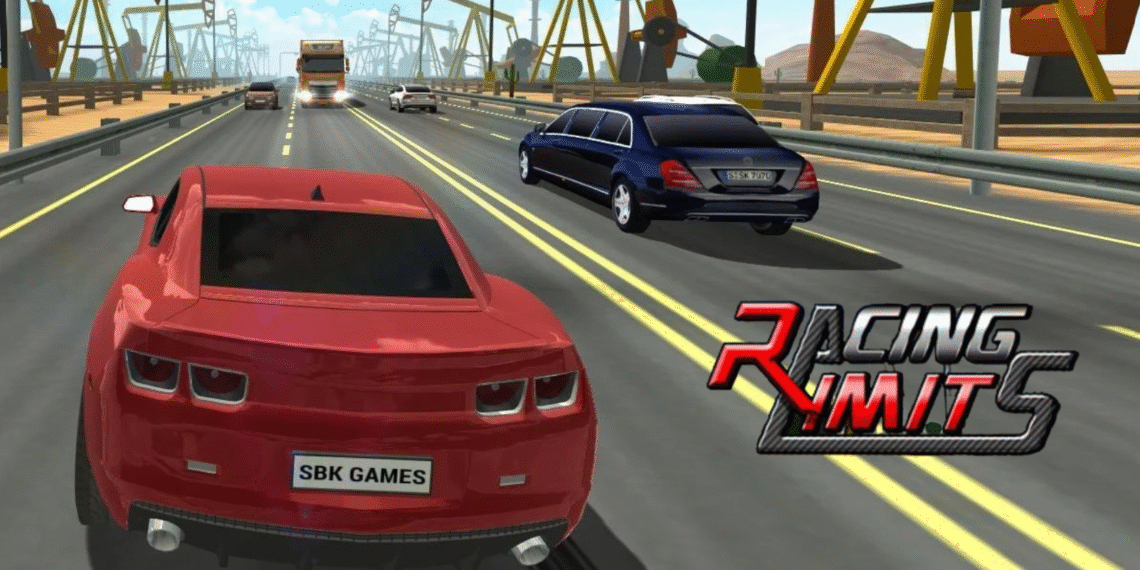First impressions of Racing Limits
The first time you open Racing Limits, it doesn’t try to impress you with a long story or overcomplicated menus. Instead, it throws you almost immediately into traffic, puts you behind the wheel, and lets the speed speak for itself. That simplicity is one of the game’s quiet strengths.
You notice right away that this is not a “flashy for the sake of being flashy” kind of racer. The interface is clean, the controls are easy to spot, and the focus is clearly on one thing: driving fast in busy traffic while staying in control. For many players, that is exactly what a mobile racing game should be.
A game that feels fast from the start
Speed is the heart of Racing Limits, and you can feel it from the very first run.
Even with the starter car, the sense of motion is strong. Vehicles zip past you in the opposite lane, your own car responds quickly to small movements, and every close overtake gives you that tiny rush of “I just made it.” The game’s camera perspective and road layout both help create that feeling of constant movement.
This early impression matters more than people realize. A lot of mobile racers feel slow until you unlock better cars. Racing Limits avoids that trap by making even the opening moments feel alive and energetic, which is one reason many players end up playing “one more run” again and again.
Visual style and overall atmosphere
Visually, Racing Limits is not trying to compete with console-level realism, but it offers a surprisingly polished look for a mobile title.
Cars are clearly modeled, traffic vehicles are varied enough to keep things from feeling repetitive, and the road environments provide a decent sense of place. The most important detail, though, is clarity. You can distinguish distance, lane positions, and upcoming cars without straining your eyes, which is critical during high-speed moments.
The atmosphere is somewhere between casual and serious. It doesn’t look like an arcade cartoon, but it also doesn’t go for ultra-gritty realism. That middle ground works nicely for a game that wants to be accessible, but still give you the feeling that you’re controlling a powerful machine in real traffic.
How the game introduces new players smoothly
One of the more underrated aspects of Racing Limits is how gently it introduces its mechanics without overwhelming you.
Instead of long tutorials, it shows you the basics through short instructions and lets you learn by doing. You discover very quickly that switching lanes at the right time, keeping enough distance, and judging gaps between cars are the core skills you’ll need.
The game doesn’t punish early mistakes too harshly either. At first, you might crash often while learning the rhythm of traffic and speed, but the runs are short and restarting is instant. This keeps frustration low and engagement high, which is a smart design choice for a mobile title.

Gameplay experience that keeps you hooked
The gameplay loop in Racing Limits is simple to describe but surprisingly rich in feel: drive fast, avoid crashing, overtake closely, and beat your previous best. That’s the foundation, and it’s a strong one.
Each run feels like a small story. Sometimes you start cautiously, then spot a clear stretch of road and suddenly decide to push your limits. Other times, you might get into a flow where everything “just clicks” and you steer through tight gaps with calm confidence. When that happens, it’s hard not to hit replay.
Core driving mechanics and responsiveness
The core driving mechanics are built around responsiveness. Steering inputs feel quick, braking is effective without being overly sharp, and acceleration increases in a way that feels consistent with each car’s statistics.
You can feel differences between vehicles as you progress. Some are heavier and more stable, while others are lighter and more nimble. That variation keeps the experience from feeling flat and gives you a reason to try and unlock better cars, not just for speed but for the way they handle.
The physics lean toward “fun realism” rather than strict simulation. You won’t be dealing with complex drifting systems or advanced weight transfer, but you will need good reaction time, anticipation, and a bit of courage when squeezing between two trucks at high speed.
Traffic, speed, and the thrill factor
Traffic is the real opponent in Racing Limits.
Cars appear in both your lane and the opposite lane, forcing you to constantly judge whether you can safely overtake or need to pull back. The game rewards near misses and close passes, which adds to the thrill but also demands focus. One careless decision is enough to end a promising run.
The thrill comes from those tiny, risky decisions you make every few seconds. Do you switch lanes now or wait? Is there enough room between those two cars? Should you stay in your lane and play it safe or dash across to the other side for extra points? Those decisions create tension, and that tension keeps you engaged.
The balance between difficulty and accessibility
Striking the right balance between difficulty and accessibility is hard, but Racing Limits handles it well.
Early on, the game is forgiving enough to let new players build confidence, but as your speed increases and traffic density rises, the challenge ramps up naturally. You don’t need to be a hardcore racing fan to enjoy it, but if you are competitive by nature, you’ll find plenty of room to chase higher scores and cleaner runs.
The controls themselves help with accessibility. They’re easy to understand, and you don’t need to memorize complex combinations. You focus on timing, observation, and instinct, which makes the game suitable for both quick sessions and longer, focused play.
Racing Limits review: why the game feels so addictive
Addictiveness in a game is usually a mix of good pacing, rewarding feedback, and clear goals. Racing Limits quietly checks all of those boxes.
It’s not a game that forces you into long commitments. Instead, it gives you short, intense bursts of play where every second counts, and then it tempts you to try again because “this time you can do better.” That simple loop is surprisingly powerful.
The reward system and progression loop
Progression in Racing Limits is driven mostly by your performance in races and how well you manage your runs.
You earn in-game currency based on distance, speed, and how closely you overtake other vehicles. Those earnings then go into new cars or upgrades. It feels fair: good driving is rewarded, and even if you crash early, you usually earn a little something for your effort.
This steady sense of progress is what keeps many players returning. You’re not grinding endlessly with no visible change. Instead, each session brings you a bit closer to your next car or improvement, and that subtle feeling of moving forward is a major part of the game’s appeal.
Car upgrades and why they matter
Upgrades in Racing Limits are more than cosmetic. They directly affect how your car behaves on the road.
Improved acceleration means you reach high speeds faster. Better handling makes lane changes feel smoother, and increased top speed opens up more room for high-score attempts. When you install an upgrade and immediately feel the difference in your next run, it’s satisfying.
This connection between effort and reward makes the upgrade system feel meaningful rather than just decorative. You’re not simply collecting cars to fill a garage; you’re actively improving your tools for the next fast, risky run on the highway.
Realistic driving modes that add depth
Another reason Racing Limits keeps players interested is its variety of driving modes and perspectives.
You can switch views to get a different sense of immersion, whether you prefer a cockpit-like experience or a more distant external camera. Each perspective changes how you read distance, gaps, and timing, which adds more depth than you might expect from a mobile racer.
Driving modes and conditions also affect how you approach each run. Traffic density, time of day, and speed limits (or the lack of them) create different rhythms, and learning to adapt to each setup gives the game long-term replay value.
Graphics, sound, and performance on different devices
On mobile, performance is just as important as visuals. If the game looks great but stutters, it’s hard to enjoy. Fortunately, Racing Limits generally manages to deliver a smooth experience while keeping visuals decent.
Road environments and day/night variations
The environments may not be wildly diverse, but they do the job well.
Changes in time of day, such as bright daylight or evening settings, give the roads a slightly different feel. Shadows, lighting, and reflections on the vehicles contribute to a stronger sense of realism, even if the level of detail is not on par with high-end console racers.
What really matters is readability. Cars, lanes, and obstacles remain clear, even at high speed. This allows you to focus on timing and decision-making instead of wondering what you’re looking at.
Sound effects that elevate the racing experience
Sound often gets overlooked in mobile reviews, but it plays a bigger role than people think. In Racing Limits, engine sounds, traffic noise, and collision effects all work together to create a stronger sense of motion.
You can hear when you’re accelerating hard, when cars are passing nearby, and when you’ve misjudged a gap. Even if the soundtrack and effects are not revolutionary, they are clean and purposeful. They support the tension and immersion rather than distracting from it.
Smooth gameplay and frame rates on mobile devices
Performance is where Racing Limits quietly shines.
The game is designed to run on a wide range of devices, and its visuals are optimized in a way that keeps frame rates stable. That smoothness is crucial in a game where a fraction of a second can decide whether you slip through a tight space or crash into a bumper.
A smooth frame rate not only feels better but also makes the game more fair. Your reactions and timing matter more when the game isn’t lagging, and Racing Limits generally delivers in that area.
Game modes that keep the experience fresh
Playing the same type of race again and again would get repetitive, no matter how fun the core driving is. Racing Limits avoids that by offering multiple modes that change your objectives and style of play.
Time mode, endless mode, and challenge runs
Different modes give you different purposes.
In some modes, you’re racing against the clock, trying to cover as much distance as possible before time runs out. In others, you may be in an endless run where the only goal is to keep going without crashing and push your own limits.
Challenge-style sessions, where you set personal goals or try to beat specific records, help the game stay fresh. Even if the environment is familiar, the stakes and goals change, so the experience feels new enough to stay interesting.
Online racing and competitive spirit
While Racing Limits is easy to enjoy alone, the competitive aspect can add another layer of motivation.
Knowing that other players are reaching higher distances, earning more points, or unlocking cars faster pushes you to refine your own driving. Even if you’re not directly racing side by side, comparing performance, rankings, or shared results can be enough to awaken your competitive side.
This sense of “friendly pressure” is a big part of why people keep revisiting the game and trying to outdo themselves.
Short sessions vs long play – a game that fits any schedule
Another subtle strength of Racing Limits is how well it fits into different lifestyles.
You can play for just a couple of minutes while waiting somewhere, finish a quick run, and feel satisfied. Or you can sit down for a longer session, try different modes, work on upgrades, and push your skills.
That flexibility makes it a great fit as a “comfort game” on your phone – something you can return to again and again, without needing to remember complicated storylines or controls.
Strengths and weaknesses of Racing Limits
No game is perfect, and a fair review should also look at where Racing Limits might fall short, even while acknowledging its many strengths.
What the game excels at
The biggest strengths of Racing Limits are its sense of speed, simple yet engaging mechanics, and satisfying progression. It understands that players want responsive controls, clear goals, and meaningful improvements to their vehicles, and it delivers in those areas.
The game also does a good job of staying accessible. You don’t need to be an expert in racing games to enjoy it. If you can react quickly and stay focused, you can have fun within minutes.
Where improvements could be made
On the other side, some players may feel that the visual variety could be greater over the long term. While the environments are functional and clean, more diverse locations, weather conditions, or traffic types could make extended play even more interesting.
There can also be moments where repetition sets in if you play too many long sessions in a row. The core loop is strong, but like any arcade-style game, it shines brightest when played in bursts rather than marathon sessions.
Who will enjoy the game the most
Racing Limits is especially well suited for players who:
- Enjoy fast, responsive mobile racers
- Like beating their own records and improving over time
- Prefer short, intense sessions over long story modes
- Appreciate a balance of realism and arcade-style fun
If you want deep narrative, open-world exploration, or highly cinematic races, this might not be the perfect fit. But if you simply want to feel the tension of weaving through traffic at high speed, this game fits that desire very well.
Final verdict: is Racing Limits worth playing?
After spending time with Racing Limits, it becomes clear why so many players find it unexpectedly addictive.
It doesn’t rely on heavy storytelling or complicated systems. Instead, it focuses on pure driving, careful timing, and the thrill of squeezing through impossible-looking gaps on the road. That focus keeps the experience tight, clear, and satisfying.
The game’s long-term appeal
The long-term appeal of Racing Limits comes from its blend of progression and skill.
As you unlock better cars and improve your driving, you feel yourself growing with the game. Runs that once felt impossible become manageable, and new goals start to appear. It’s that ongoing personal challenge that makes you keep coming back.
How it stands among other mobile racing games
Among mobile racers, Racing Limits holds its own by being honest about what it is.
It’s not an open-world car collector. It’s not a Hollywood-style racing movie in game form. It’s a focused, traffic-based racer where your reflexes, judgment, and courage decide how far you go. That clarity of identity helps it stand out in a crowded genre.
Why it still feels fresh after hours of play
Even after many runs, Racing Limits remains engaging because every drive is slightly different.
Traffic patterns change, your reactions change, and your willingness to take risks changes from day to day. Each attempt becomes its own little story of close calls, bold overtakes, and the occasional spectacular crash.
In the end, Racing Limits is exactly what its name suggests: a game about pushing your own limits on the road, one fast, intense run at a time. If that idea appeals to you, this is a ride that is absolutely worth taking.
FAQs
Is Racing Limits a realistic driving game?
Racing Limits offers a balanced blend of arcade fun and light realism. While it doesn’t behave like a full simulation racer, its speed, traffic behavior, and handling feel believable enough to keep the experience immersive and exciting.
Can beginners enjoy Racing Limits easily?
Yes, beginners can pick it up quickly. The controls are simple, the game introduces mechanics naturally, and early crashes aren’t overly punishing. It’s designed to be accessible for new players while still offering depth for experienced ones.
Does Racing Limits require a powerful mobile device?
The game is well optimized for a wide range of devices. Even older or mid-range phones can usually run it smoothly, which is important for a fast-paced racing experience where performance matters.
Are car upgrades important in Racing Limits?
Upgrades make a real difference. Improving acceleration, handling, and speed enhances how your car feels on the road and helps you achieve better results in longer, faster runs.
What makes Racing Limits addictive compared to other mobile racers?
Its addictiveness comes from short, intense runs, responsive controls, rewarding progression, and the constant urge to beat your previous best. Every attempt feels different, which keeps players returning again and again.















